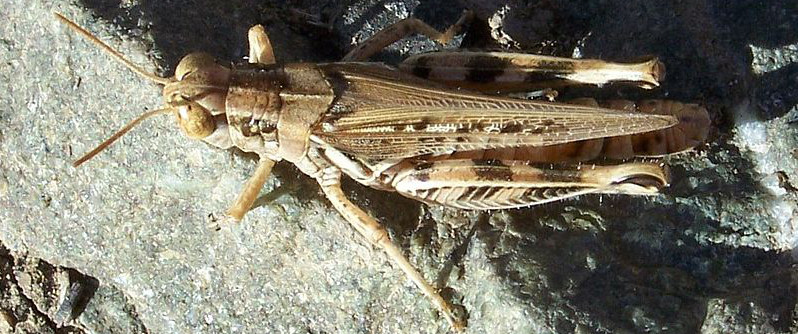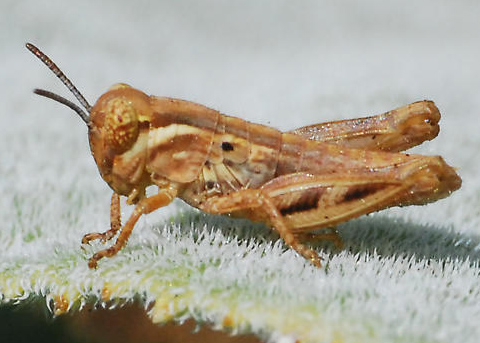
Facts
Since the devastating grasshopper does not have a picky
palate, some may assume that it’s able to thrive in a wide
variety of environments. This, however, is not the case, because
there are more issues than simply the availability of food when
discussing where an organism will thrive. Melanoplus devastator
is extremely sensitive to changes in climate (Tatar et al.
1997). The particular climate range is what keeps this species
of grasshopper in its native homeland of the Californian
portions of the west coast. Since the climate and conditions are
hospitable for the grasshopper, it is also here that the
grasshopper does the most damage.
Through
various studies, scientists have come to realize how profound
the effects of elevation are on the rate of aging in the
Melanoplus devastator. Grasshoppers that are found in areas of
low elevation have been noted to have longer lifespans compared
to those who live in regions of higher elevation (Tatar et al.
1997). Elevation affected, not only was the lifespan, but also
the average body size of grasshoppers. Therefore, the
grasshoppers in high elevation that had shorter lifespans also
displayed smaller body size; the lower elevation grasshoppers
that lived longer were also larger in size (Tatar et al. 1997).
This relationship, however does not indicate direct causation
that all small devastating grasshoppers are from regions of high
elevation and are destined to die early, it does, however,
suggest correlation between the two factors. There is a clear
relationship between the genetics of grasshoppers and the
environmental factors that they face (Tatar et al. 1997).
The unique
relationship between the grasshopper and its environment also
leads to another interesting piece of information about this
devastating little insect. It isn’t confined with mating with
grasshoppers within the Melanoplus devastator species, in fact,
it has been known to mate and hybridize with Melanoplus
sanguinipes (Orr et al. 1993). These two species are considered
to be distinct from one another but that doesn’t completely
prevent them from forming offspring with one another. Throughout
the Sierra Nevada area of California there are hybrid zones in
which these two species of grasshoppers have commonly been known
to mate and produce offspring (Orr et al. 1993). Sometimes when
organisms from different species mate and attempt to reproduce,
their offspring die at a young age or are infertile. However, in
the case of the Melanoplus devastator and the Melanoplus
sanguinipes their offspring are viable (Orr et al. 1993).
Though not
every condition is favorable for the devastating grasshopper, it
still finds ways to do immeasurable amounts of damage to gardens
and crops in the California area. Because it can also interbreed
with the Melanoplus sanguinipes, the grasshopper’s habitat range
can spread into the hybrid zones as well (Orr et al. 1993).
Because the grasshopper can eat nearly any plant that is in its
environment, it isn’t a particularly to get rid of. In general,
if grasshoppers are a problem, b order plowing is among the most
effective ways to stop the eggs from hatching and the
grasshoppers from damaging crops (Bentley and Philips 1992).
Insecticides can be effective when battling nymphs and adult
devastating grasshoppers (Bentley and Philips 1992). If you or
someone you know is fighting to rid their garden, crop, or
vineyard from these pests, remind them to read directions and
labels carefully before using the product. Don’t let your hard
work be devastated by the Melanoplus devastator or the
Melanoplus sanguinipes, but please also consider the effects
insecticides will potentially have on the environment.
order plowing is among the most
effective ways to stop the eggs from hatching and the
grasshoppers from damaging crops (Bentley and Philips 1992).
Insecticides can be effective when battling nymphs and adult
devastating grasshoppers (Bentley and Philips 1992). If you or
someone you know is fighting to rid their garden, crop, or
vineyard from these pests, remind them to read directions and
labels carefully before using the product. Don’t let your hard
work be devastated by the Melanoplus devastator or the
Melanoplus sanguinipes, but please also consider the effects
insecticides will potentially have on the environment.
Move back to Interactions Home Page Go to References